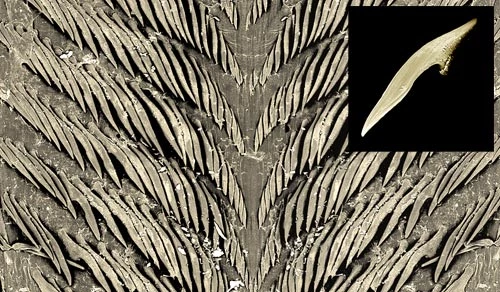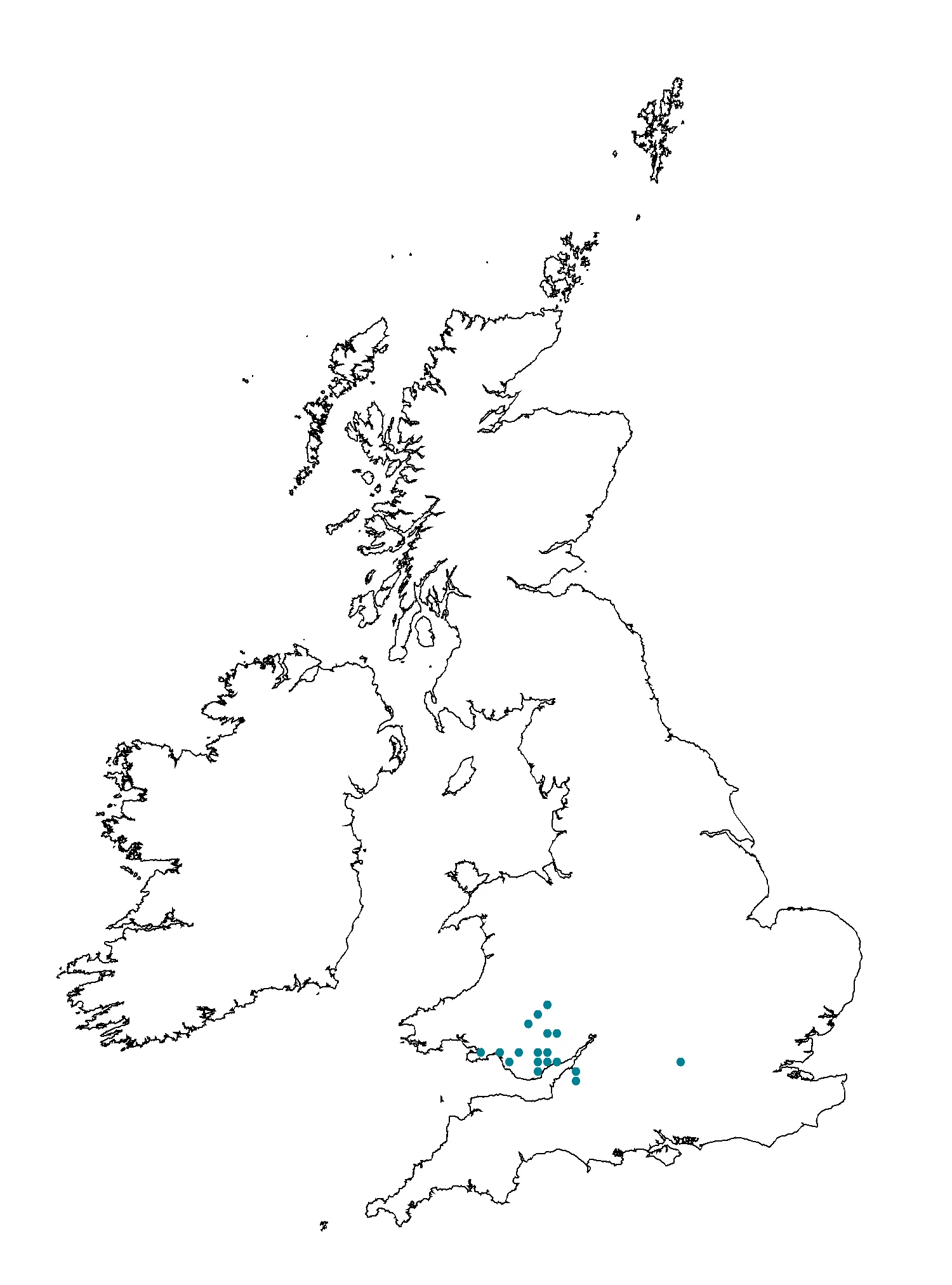The Long Reach of the Ghost Slug
An adult Ghost Slug, about 7cms long.
The Ghost Slug's blade-like teeth, each about half a millimetre long. These are much longer and sharper than those of herbivorous species.
Close-up of the Ghost Slug's head. The eyes, if present, would normally be at the tips of the two upper (longer) tentacles.
Verified Ghost Slug records received until Autumn 2013.
The bizarre Ghost Slug made headlines in 2008 when described as a new species from a Cardiff garden. When the first specimens were found, very little was known about this animal. The story since then connects our collections and specialist expertise with sharp-eyed members of the British public, recording networks, other taxonomists in Europe, and the media to show how a picture is emerging.
The species
Emphasizing its spooky nature, we gave the species the scientific name Selenochlamys ysbryda, based on the Welsh word ysbryd, meaning a ghost or spirit. The common name “Ghost Slug” soon became popular. Identifying it with the obscure genus Selenochlamys was a specialist task and required dissection of several specimens including our holotype. (Incidentally, Selenochlamys already combines the Greek words for a cloak, and Selene, goddess of the moon, but “Moon-Cloaked Ghost Slug” sounded a little too melodramatic.)
The Ghost Slug is strange in many ways. It is extremely elusive, living up to a metre deep in soil, only rarely visiting the surface. It seldom occurs in large numbers. This makes it an unusually difficult slug to look for, especially in other people’s gardens or other places that cannot be dug up.
It is also very distinctive. After having examined one, most agree that it is unmistakeable in future (haunting, perhaps?). The slug is ghostly white, and almost eyeless. It does not eat plants, but kills and eats earthworms, whose burrows it can enter with its extremely extensible body. This differs from that of most other slugs in having the breathing hole right at the tail, and in retracting like the finger of a glove, appearing to suck its own head inside-out. Unlike some British slugs, it can be identified with certainty from a good photograph. The photos here show some similar species often confused with it.
This combination of being elusive and distinctive makes the species perfect for a public recording project. We needed to know more, not just out of curiosity, but because the species might pose a threat to earthworm populations. It appeared to have been introduced from overseas, i.e. to be an alien or non-native species, whose spread might cause concern. We thank the then Countryside Council for Wales (now part of Natural Resources Wales) for funding early survey work and information dissemination in 2009, and others who have spread the word.
Contributions from the public
Since 2008, responses from over 300 people all over the UK (and a few from overseas) have been received and replied to. A large proportion were misidentifications, but many were correct and over 25 populations of Ghost Slugs are now known. These verified records have been submitted to the National Biodiversity Network via the Conchological Society of Great Britain and Ireland. We thank all respondents for their efforts, without which almost none of the populations would have been identified.
As the map shows, the Ghost Slug is widespread in south-east Wales, occurring in all the main Valleys and in the cities of Cardiff and Newport, and at two sites in Bristol. It remains, however, rare or absent in some nearby areas (such as Swansea) and by no means occurs throughout this region. Virtually all the records are from gardens, allotments, or nearby roads and riversides in populated areas. This is also true of an unexpected outlier, reported in May 2013 from Wallingford, Oxfordshire, which might indicate an eastward spread. The species is evidently firmly established in Britain and has survived the unusually cold, dry, or wet winters of the last five years.
Contributions from specialists
This species has had at least 10 years to be spread around Britain, but has not yet been seen elsewhere in Western Europe. The earliest records are from Brecon Cathedral in 2004 (in a 2009 paper by German-based taxonomists) and from Caerphilly in 2006 (on a pet invertebrates forum). We expected its origin to be in the Caucasus Mountains of Georgia and Russia or in northern Turkey, where other Selenochlamys occur. However, a 2012 paper by a Ukraine-based taxonomist described a museum specimen of S. ysbryda collected in Crimea in 1989. This makes some sense – Crimea has a number of endemic molluscs, and several alien species now in Britain were originally described from the region. The UK also has a history of conflict and trade with Crimea (there is even a Sebastopol near a slug population in Cwmbran!) making a direct, accidental introduction plausible.
DNA was sequenced from six specimens of the Ghost Slug, from Cardiff, Newport, Bristol, and Talgarth as part of our recent studies on British Slugs. The sequences were all but identical, supporting the theory that the species is not native to the UK.
If you are going to report a sighting, please ensure that your slug is a true Ghost Slug (Selenochlamys ysbryda). This can be done by looking at the mantle and the eyes. The mantle (indicated by the grey lines) looks like a layer of skin through which the breathing hole is often visible.
This Ghost Slug has a tiny, disc-shaped mantle at the rear end of its body. It has no eye spots on its tentacles (indicated by the arrow).
Other white or pale slug species have a large, cloak-like mantle over their “shoulders” near the front of their body. They have black eye spots at the tips of two of their tentacles.
The two shown here are the Netted Field Slug (Deroceras reticulatum) and Worm Slug (Boettgerilla pal lens). These species are very common in gardens, so there is no need to report them to us.
The media
The Ghost Slug was named one of the "Top 10 New Species of the Year" for 2009 by the US International Institute for Species Exploration. It has featured in exhibitions in Cardiff and Bristol, and even in school exam questions. It has also appeared in several books including Animal (Dorling Kindersley, 2011) and, most recently, in our own 2014 guide to the slug species of Britain and Ireland.
Further sightings
To monitor any spread or document behaviours we are still interested in future observations of Selenochlamys ysbryda, verified with a specimen or photograph. Please ensure that they are not the Netted Field Slug Deroceras reticulatum, shown above. To report a Ghost Slug, email
Ben Rowson .



Comments - (48)
Dear Maxine
Thanks for your enquiry. Without a photo I can’t be quite sure what kind of slug this was, but 3 inches would be a very large size for either a Ghost Slug or a Shelled Slug (Testacella). When handled, Testacella sometimes regurgitates partially-digested earthworms, including the worms’ orange-brown body fluid. However, several other types of large slugs produce orange mucus or other disgusting fluids when injured, so I’m afraid that doesn’t really narrow it down. If you see another one, maybe you can get a picture.
Best wishes
Ben
Hi everyone
Many thanks to all those who have posted comments recently (even on Christmas Day!). The best way to ensure your records get added to the database is to email me directly (there is a link above). I do reply to them all, and all verified records are added to the NBN map at the end of each year. In 2020 there were several new Ghost Slug sightings in North and South Wales and from Gloucestershire, and even the first from Northamptonshire. In 2019 we saw the first confirmed records from North Wales and from Devon. Well spotted everybody, and thanks for sending them in.
Best wishes
Ben